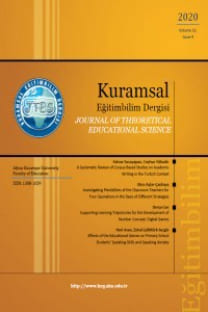Secondary School Students’ Views on Computer Assisted Mathematics Instruction
Ortaöğretim Öğrencilerinin Bilgisayar Destekli Matematik Öğretimi Hakkındaki Görüşleri
___
- Alakoç, Z. (2003). Matematik öğretiminde teknolojik modern öğretim yaklaşımları. The Turkish Online Journal of Educational Technology, 2(1), 1-7.
- Alkan, C. (1995). Eğitim teknolojisi. Ankara: Atilla Kitapevi.
- Arseven, A. (1986). Bilgisayar destekli öğretim. TED I. Bilgisayar Eğitimi Toplantısında sunulmuş sözlü bildiri, Ankara, Türkiye.
- Baki, A. (2002). Öğrenen ve öğretenler için bilgisayar destekli matematik. Ankara: Ceren Yayın-Dağıtım.
- Bedir, D. (2005). Bilgisayar destekli matematik öğretiminin ilköğretimde geometri öğretiminde yeri ve öğrenci başarisi üzerindeki etkisi (Yayımlanmamış yüksek lisans tezi). Dokuz Eylül Üniversitesi, İzmir.
- Birgin, O., Çatlıoğlu, H., Coştu, S., & Aydın, S. (2009). The investigation of the views of student mathematics teachers towards computer-assisted mathematics instruction. Procedia Social and Behavioral Sciences, 1(1), 676-680.
- Çakır, İ. (2006). The use of video as an audio-visual material in foreign language teaching classroom. The Turkish Online Journal of Educational Technology, 5(4), 67-72.
- Çilenti, K. (1985). Fen eğitimi teknolojisi. Ankara: Kadıoğlu Matbaası.
- Ersoy, Y. (2005). Matematik eğitimini yenileme yönünde ileri hareketler-I: Teknoloji destekli matematik öğretimi. The Turkish Online Journal of Educational Technology, 4(2), 1-13.
- Gönen, S., Kocakaya, S., & İnan, C. (2006). The effect of the computer assisted teaching and 7E model of the constructivist learning methods on the achievements and attitudes of high school students. The Turkish Online Journal of Educational Technology, 5(4), 82-88.
- Gülcü, A. (2004). Mathematica 5 bilgisayar destekli matematik. Ankara: Nobel Yayın Dağıtım.
- Gülcü, A., & Alan, M. A. (2003). Bilgisayarın temelleri ve İnternet rehberi. Ankara: Detay Yayınları.
- Harbe, S., & Grundmeier, T. A. (2007). Prospective mathematics teachers’ views on the role of technology in mathematics education. IUMPST: The Journal, 3.
- Heddens, J. W., & Speer, R. W. (1997). Today’s mathematics. New Jersey: Merrill. Işık, C. (2007). Bilgisayarla görselleştirmenin iki değişkenli fonksiyonlarda limit kavramının öğretiminde öğrenci başarısına etkisi. Journal of Qafqaz University, 19, 132-141.
- Kariuki, P., & Burkette, L. (2007). The effects of teacher mediation on kindergarten students’ computer-assisted mathematics learning. Paper presented at the Annual Conference of the Mid-South Educational Research Association, Hot Springs, Arkansas.
- Keser, H. (1988). Bilgisayar destekli eğitim için bir model önerisi (Yayımlanmış doktora tezi). Ankara Üniversitesi, Ankara.
- Kutluca, T., & Birgin, O. (2007). Evaluation of prospective mathematics teachers’ views about computer assisted teaching material developed in the linear equation topic. Gazi Eğitim Fakültesi Dergisi, 27(2), 81-97.
- Milli Eğitim Bakanlığı. (2010). http:// ttkb.meb.gov.tr/ogretmen/modules.php?name= Downloads&d_op =viewdownload&cid=75&min=30&orderby=titleA&show=10 adresinden indirilmiştir.
- Moore, J. M. (2002). A graphics calculator-based college algebra curriculum: Examining the effects of teaching college algebra through modeling and visualization to enhance students’ achievement in and attitudes toward mathematics. Dissertation Abstract Index, 63(3), 221.
- Olusi, F. I. (2008). Using computer to solve mathematics by junior secondary school students in Edo State Nigeria. College Student Journal , 42(3), 748-755.
- Peker, Ö. (1985). Ortaöğretim kurumlarında matematik öğretiminin sorunları. Ankara: TED Yayınları
- Phonguttha, R., Nuangchalerm, P., & Tayraukham, S. (2009). Comparisons of mathematics achievement, attitude towards mathematics and analytical thinking between using the geometer's sketchpad program as media and conventional learning activities. Australian Journal of Basic and Applied Sciences, 3(3), 3036- 3039.
- Samuelsson, J. (2006). ICT as a change agent of mathematics teaching in Swedish secondary school. Education and Information Technologies, 11, 71-81.
- Tabuk, M. (2003). İlköğretim 7. sınıflarda “çember, daire ve silindir” konusunun öğretiminde bilgisayar destekli öğretimin başariya etkisi (Yayımlanmamış yüksek lisans tezi). Marmara Üniversitesi, İstanbul.
- Tall, D. O., & Razali, M. R. (1993). Diagnosing students’ difficulties in learning mathematics. International Journal of Mathematical Education in Science and Technology, 24(2), 209-222.
- Teinken, C. H., & Wilson. M. J. (2007). The impact of computer assisted instruction on seventh-grade students’ mathematics achievement. Planning and Changing, 38(3), 181-190.
- Tezer, M., & Kanbul, S. (2009). Opinions of teachers about computer aided mathematics education who work at special education centers. World Conference on Educational Sciences, Nicosia, North Cyprus.
- Tutak, T., & Birgin, O. (2008). The effects of computer assisted instruction on the students’ achievement in geometry. Proceedings of the 8th International Educational Technology Conference, 1062-1065.
- Yıldırım, A., & Şimşek, H. (2008). Sosyal bilimlerde nitel araştirma yöntemleri. Ankara: Seçkin Yayıncılık.
- Yurdakul, B. (1998). Eğitimde bilgisayar teknolojisine ilişkin uygulamalarin değerlendirilmesi (Yayımlanmamış yüksek lisans tezi). Ankara Üniversitesi, Ankara.
- ISSN: 1308-1659
- Yayın Aralığı: 4
- Başlangıç: 2008
- Yayıncı: Afyon Kocatepe Üniversitesi Eğitim Fakültesi
Matematik Odaklı Epistemolojik İnanç Ölçeği (MOEİÖ): Geçerlik ve Güvenirlik Çalışması
The Mathematics-Oriented Epistemological Belief Scale (MOEBS): Validity and Reliability Study
Lise Öğrencilerinin Öznel İyi Oluşlarının Yordayıcısı Olarak Öz-Yeterlik
Ortaöğretim Öğrencilerinin Bilgisayar Destekli Matematik Öğretimi Hakkındaki Görüşleri
Türk Edebiyatı Ders Kitabının Yapılandırmacı Öğrenme Yaklaşımına Göre Değerlendirilmesi
Üstün Yetenekli Öğrencilerin Bilimsel Tutum Düzeyleri (Malatya Örneği)
Scientific Attitude Levels of Gifted Students (A Case from Malatya)
Secondary School Students’ Views on Computer Assisted Mathematics Instruction
İlköğretim Öğrencilerinin Geometrik Cisimlerle İlgili Kavram Bilgilerinin Analizi
